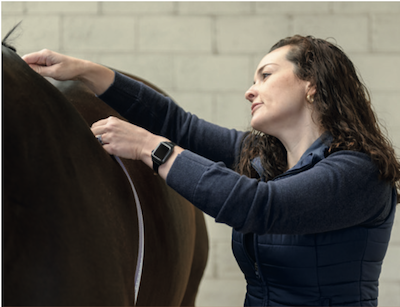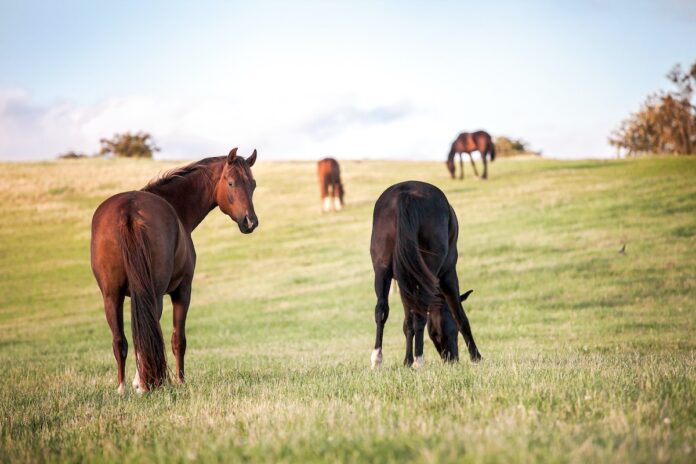Feeding for Optimum Condition

By Dr. Courtney Miller, BS BVetMed MRCVS, head of nutrition at Dodson & Horrell
RAMAs/SQPs must earn a certain number of CPD points in a given period of time in order to retain their qualification. RAMAs/SQPs who read this feature and submit correct answers to the questions below will receive two CPD points.
Keeping horses and ponies at their optimum condition is vital to maintain overall health and welfare.
There are many ways to define condition, but one of the most universally accepted meanings measures body condition. This is partially because it is difficult to adapt a system like the body mass index (BMI) scoring in people to suit horses and ponies, and partially because there is a need for a system that is practical and easy to use on the yard. Several other systems that measure aspects of condition have been developed, but their ease of use makes them less practical alternatives.

There are two main body condition scoring systems. One involving a five-point scale and the other a nine-point scale. Both are perfectly suitable, so user preference should dictate which is chosen and utilised consistently to compare data across time periods.
It is the monitoring itself that is most important, so that unwanted small changes can be caught and corrected early. And once a good condition score for an individual horse or pony is set, body weight can be layered in and used at the set monitoring intervals, ideally every two to four weeks, to further help pick up on small changes before they become difficult to reverse.
Once ideal condition for an individual is defined and a monitoring system is in place, a thorough history that includes each horse or pony’s breed, sex, workload, clinical history and temperament should be collected. This will ensure that any diet recommended will encompass all individual needs; and the regular monitoring described above will help assess whether it is as suitable in practice as it is in theory to maintain optimum condition.
POOR-DOERS
Some horses do not maintain weight easily and it can prove a real challenge to keep them in good condition. These ‘poor-doers’ require more energy and protein to maintain and build body condition. When energy and protein are not provided in sufficient levels in the diet, the horse will begin to use its own muscle tissues and fat reserves, resulting in weight loss and loss of muscle mass.
Our first reaction may be to reach for larger quantities of hard feed in these cases, but it is important not to forget the significant contribution forage makes towards energy and protein in the overall diet, as well as its role in maintenance of a healthy hindgut and digestive functionality.
Enough forage in the diet is very important for digestive function as well as physical and psychological health. The horse has a limited capacity to digest starch due to their lack of amylase, an enzyme that breaks down starch.
When horses eat a large volume of grain in one sitting, undigested starch passes through to the large intestine where it is fermented by bacteria that produce lactic acid as a product of fermentation. Lactic acid reduces the pH in the hindgut and makes the environment more acidic.
The fibre fermenting bacteria die due to their sensitivity to a low pH environment, whilst the lactic acid-producing bacteria thrive due to their ability to survive in acidic environments. This further decreases the pH in the hindgut which in worst case scenarios can lead to acidosis, laminitis, and colic due to the toxins produced when the fibre degrading bacteria die.
This in turn, can be the cause of a horse’s reduced ability to maintain weight and condition.
While forages such as pasture, hay and chaff are recognised sources of fibre, there are other forages that can be used to help build and maintain condition.
For example, sugar beet is commonly referred to as a ‘super- fibre’ because it contains high amounts of digestible fibre, mostly pectin, which is more digestible than other fibre sources commonly found in hay. Hay is 40-60% digestible while sugar beet is approximately 80% digestible.
Legumes such as alfalfa and sainfoin are also great fibre sources for those that need to build condition. They are very digestible and therefore have a high energy content making them ideal for those that have difficulty maintaining weight.
If high fibre ingredients and forages are not enough to be able to build and maintain condition in the diet, selection of the types of nutrients in the complementary hard feed that is chosen can help ensure total diet stays well suited to the individual.
A good example of when this is very relevant is in an excitable horse who is a poor-doer. Increasing condition whilst maintaining a cool head in these horses can sometimes prove problematic.
Research has shown that maintaining fizzy horses on a high fibre and high oil diet is the best way to manage over-excitable behaviour. However, when condition is poor, and calories in the diet must be increased, often energy-dense cereals like barley can seem like an appealing choice. However, cereals have a high starch content, and this added starch in the diet can make these individuals difficult to handle and ride.
Alternative sources of energy, such as oils and proteins, can be more suitable to use in these horses. This blend of oils and proteins is sometimes referred to as ‘cold energy’.
GOOD-DOERS
While some horses do not hold weight well, others can hold weight and condition easily. These horses are considered to be ‘good- doers’. Native breeds such as the New Forest, the Highland and the Clydesdale are often associated with being good-doers.
Nutrition plays a vital part in maintaining a healthy weight. Trying to help your horse or pony to lose weight can feel an impossible task; research shows that over 50% of leisure horses in the UK are overweight or obese, which increases the risk of problems such as laminitis or equine metabolic syndrome.
Deciding on the right diet for your good-doer can prove to be a challenge. The most important thing is not to starve them.
Horses are trickle feeders and evolved to spend most of their time eating. This is important for both their physical and mental wellbeing and it is recommended that horses should receive between 2 and 2.5% of their bodyweight per day of forage.
For overweight horses, this may need to be restricted to 1.5 to 2% of their bodyweight per day. Restricting their forage intake should always be done under veterinary supervision, as severe feed restriction can result in behavioural and health problems such as stereotypies, gastric ulcers, colic or a life-threatening condition called hyperlipaemia.
Limiting their daily intake of calories is usually the first step as well as utilising low calorie feeds and forages.
Grass is a major source of calories - some horses can eat 5% of their bodyweight in grass per day (dry matter), gaining 21kg in a week. Restricting turnout time may not be enough; horses may adapt to this by eating more in a shorter period.
You could consider using a grazing muzzle which can lower grass intake by as much as 83%. Other methods of reducing grass intake include strip grazing, cutting the grass or increasing the number of horses in a given area.
If your horse is very overweight, turning them out on an all- weather surface with access to soaked hay or straw could be beneficial. Soaking the hay for 12 hours can reduce the water- soluble carbohydrate and calorie content of the forage.
Another option is to mix hay with lower calorie oat or barley straw. Haylage is not normally recommended for overweight horses or ponies as it is typically more digestible than hay or straw. However, there are now many lower sugar, higher fibre haylages available on the market. Monitoring the nutritional content of your horse’s forage plays a large part in weight management for good doers.
Overweight horses and ponies sometimes require a low calorie, low intake feed alongside their forage to ensure they are receiving a fully balanced diet. Rather than feeding them a standard mix or cube, which could oversupply calories, there are lower intake alternatives to ensure they are receiving the nutrients they need whilst maintaining a calorie-controlled ration.
Including a feed balancer in the horse’s diet is a great way of doing this. There are a range of balancers on the market to suit every horse’s individual needs; these may include added digestive support, hoof support and immune support.
Balancers can be fed with a chaff; in the case of good-doers, low calorie straw-based chaffs are best in most cases. Vitamin and mineral top-ups are also a good option, these can come in the form of stable/field licks and supplements to balance a fibre-based diet.
Optimising your horse’s condition is vital for their overall health and welfare. Finding the right feeding regime for your individual horse relies on multiple factors; there is no one solution for feeding to maintain optimum condition.
It is about knowing your individual horse and making sure you have selected ingredients and nutrients that suit them as well as consistently monitoring them and making small dietary adjustments as required.

ETN’s series of CPD features helps RAMAs (Registered Animal Medicines Advisors/SQPs) earn the CPD (continuing professional development) points they need. The features are accredited by AMTRA, and highlight some of the most important subject areas for RAMAs/SQPs specialising in equine and companion animal medicine.
AMTRA is required by the Veterinary Medicines Regulations to ensure its RAMAs/SQPs undertake CPD. All RAMAs/SQPs must earn a certain number of CPD points in a given period of time in order to retain their qualification. RAMAs/SQPs who read this feature and submit correct answers to the questions below will receive two CPD points. For more about AMTRA and becoming a RAMA/SQP, visit www.amtra.org.uk
Horses in a field photo by Louise Pilgaard











